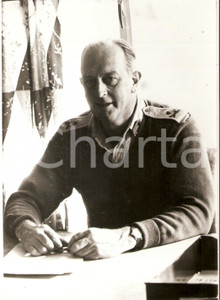30th May 1940, Ardennes WW2
Commander of French Troops fighting beside B.E.F. in historic battle
Photo shows the General Blanchard while commanding the French troops trying to fight their way out of the ring formed by overhelming German forces in northern France as a result of the capitulation of King Leopold of the Belgians.
Blanchard was working in close co-operation with General Lord Gort, Commander-in-chief of the British Expeditionary Force.
Fotografia d'epoca del Generale Blanchard, Comandante in capo delle truppe francesi nel tentativo di respingere l'assedio tedesco dopo la caduta del Belgio.
Photo Planet News - London
Vera fotografia d'epoca, originale, autentica.
Sono presenti il timbro datario e l'originale nota dattiloscritta al verso (lingua inglese).
L'immagine versa in mediocri condizioni e presenta varie macchie di umidità (ben visibili nella scansione). Di tale circostanza si è naturalmente tenuto conto nella determinazione del prezzo.
--------------------
Note: In the Second World War, the Battle of France was the German invasion of France and the Low Countries, executed on 10 May 1940, which ended the Phony War. The battle consisted of two main operations. In the first, Fall Gelb (Case Yellow), German armoured units pushed through the Ardennes, to cut off and surround the Allied units that had advanced into Belgium. During the fighting, the British Expeditionary Force (BEF) and many French soldiers were evacuated from Dunkirk in Operation Dynamo.
In the second operation, Fall Rot (Case Red), executed from 5 June, German forces outflanked the Maginot Line and pushed deep into France. Italy declared war on France on 10 June and soon afterwords the French government fled to the city of Bordeaux. France's capital of Paris was occupied on 14 June. On 17 June, Philippe Pétain publicly announced France would ask for an armistice. On 22 June, an armistice was signed between France and Germany, going into effect on 25 June. For the Axis Powers, the campaign was a spectacular victory.
France was divided into a German occupation zone in the north and west, a small Italian occupation zone in the southeast, and an unoccupied zone, the zone libre, in the south. A rump state, Vichy France, administered all three zones according to the terms laid out in the armistice. In November 1942, the Axis forces also occupied the zone libre, and metropolitan France remained under Axis occupation until after the Allied landings in 1944. The Low Countries remained under German occupation until 1944 and 1945.
